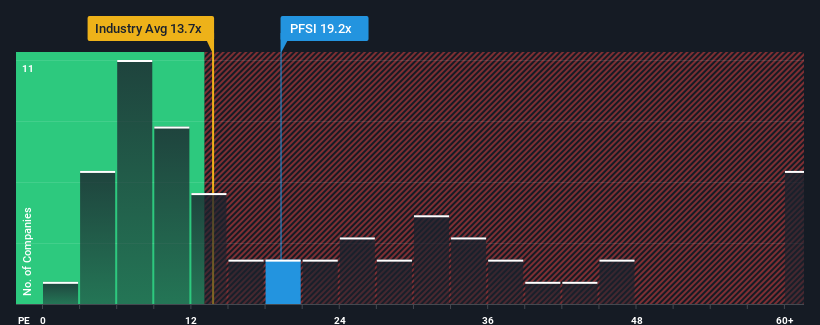- United States
- /
- Diversified Financial
- /
- NYSE:PFSI
PennyMac Financial Services, Inc.'s (NYSE:PFSI) Price In Tune With Earnings

With a price-to-earnings (or "P/E") ratio of 19.2x PennyMac Financial Services, Inc. (NYSE:PFSI) may be sending bearish signals at the moment, given that almost half of all companies in the United States have P/E ratios under 16x and even P/E's lower than 9x are not unusual. However, the P/E might be high for a reason and it requires further investigation to determine if it's justified.
PennyMac Financial Services has been struggling lately as its earnings have declined faster than most other companies. It might be that many expect the dismal earnings performance to recover substantially, which has kept the P/E from collapsing. You'd really hope so, otherwise you're paying a pretty hefty price for no particular reason.
View our latest analysis for PennyMac Financial Services

Does Growth Match The High P/E?
In order to justify its P/E ratio, PennyMac Financial Services would need to produce impressive growth in excess of the market.
Retrospectively, the last year delivered a frustrating 61% decrease to the company's bottom line. This means it has also seen a slide in earnings over the longer-term as EPS is down 75% in total over the last three years. Accordingly, shareholders would have felt downbeat about the medium-term rates of earnings growth.
Turning to the outlook, the next year should generate growth of 72% as estimated by the six analysts watching the company. That's shaping up to be materially higher than the 9.9% growth forecast for the broader market.
In light of this, it's understandable that PennyMac Financial Services' P/E sits above the majority of other companies. It seems most investors are expecting this strong future growth and are willing to pay more for the stock.
What We Can Learn From PennyMac Financial Services' P/E?
Typically, we'd caution against reading too much into price-to-earnings ratios when settling on investment decisions, though it can reveal plenty about what other market participants think about the company.
As we suspected, our examination of PennyMac Financial Services' analyst forecasts revealed that its superior earnings outlook is contributing to its high P/E. At this stage investors feel the potential for a deterioration in earnings isn't great enough to justify a lower P/E ratio. Unless these conditions change, they will continue to provide strong support to the share price.
It's always necessary to consider the ever-present spectre of investment risk. We've identified 3 warning signs with PennyMac Financial Services (at least 1 which can't be ignored), and understanding them should be part of your investment process.
Of course, you might find a fantastic investment by looking at a few good candidates. So take a peek at this free list of companies with a strong growth track record, trading on a low P/E.
New: Manage All Your Stock Portfolios in One Place
We've created the ultimate portfolio companion for stock investors, and it's free.
• Connect an unlimited number of Portfolios and see your total in one currency
• Be alerted to new Warning Signs or Risks via email or mobile
• Track the Fair Value of your stocks
Have feedback on this article? Concerned about the content? Get in touch with us directly. Alternatively, email editorial-team (at) simplywallst.com.
This article by Simply Wall St is general in nature. We provide commentary based on historical data and analyst forecasts only using an unbiased methodology and our articles are not intended to be financial advice. It does not constitute a recommendation to buy or sell any stock, and does not take account of your objectives, or your financial situation. We aim to bring you long-term focused analysis driven by fundamental data. Note that our analysis may not factor in the latest price-sensitive company announcements or qualitative material. Simply Wall St has no position in any stocks mentioned.
About NYSE:PFSI
PennyMac Financial Services
Through its subsidiaries, engages in the mortgage banking and investment management activities in the United States.
Moderate and fair value.

